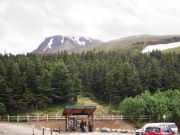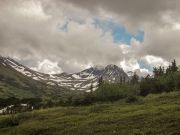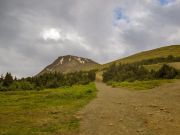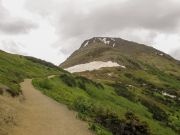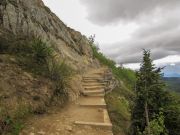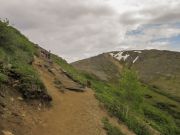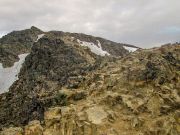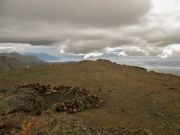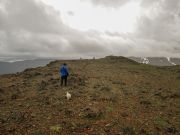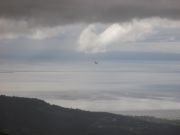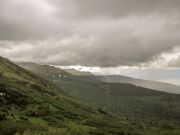
Alaska
www.surgent.net |
| Flattop Mountain |
• Chugach Mountains • Anchorage City & Borough |
Date: June 3, 2016
• Elevation: 3,510 feet
• Prominence: 229 feet
• Distance: 3.2 miles
• Time: 90 minutes
• Gain: 1,350 feet
• Conditions: Cold with drizzly rain at the top, good views below the cloud ceiling
Main
•
PB
I was in Alaska with my father and brother and his family. We had flown in yesterday and would be heading up to Denali National Park tomorrow. Today was an open day.
I had already made advance plans to hike a peak, any peak, just to say I had climbed a peak in Alaska. The Chugach Mountains rise high above Anchorage to the east, and these are not small peaks either. Most of its summits are snow and glacier-bound, with craggy rock, peaks that would take a day minimum to climb. I did not have that kind of time, nor any gear with me more advanced than hiking shoes and a jacket.
However, there is one fantastic option: Flattop Mountain, which is a bump along a ridge that rises to top out at Ptarmigan Peak. I could even see the peak when we had landed at the airport. Flattop Mountain does not have much prominence (about 250 feet), but it does have a trail which gains over 1,300 vertical feet, and includes a little hand-over-hand scrambling near the top. It is Anchorage's most popular hike, and is apparently hiked hundreds of times daily. A wilderness experience this would be not, but it looked like a great hike on its own merits.
Also, there is an outfit in downtown Anchorage that rents bicycles and also offers a shuttle service to the trailhead for a reasonable price. This would absolve me of needing to get a taxi or rent a car. I went through the Hike Alaska website to get my name in their list.
From the hotel, I walked into town deliberately early so I could tour the streets, see what kind of shops there were. I popped into the bike shop to make myself known and sign a couple waiver sheets, plus meet Peter, the owner and shuttle bus driver and all-around cool dude. We were set to depart at 12:45, so I hung out there starting at 12:30, meeting a few other hikers in the interim. The murals nearby depict the great 1964 earthquake, with lots of photos showing the incredible damage.
We piled into the van, about eight of us plus Peter. He pointed out sights in the city. The drive to the trailhead took about 30 minutes. When we arrived, the cloud ceiling was lower—or more accurately, we were higher up, about elevation 2,000 feet. The clouds were bunched up against the peaks, as they always apparently do here.
I was moving quickly. The trail is easy to find and in great shape. It's wide and flat, with no rocks or ankle-twisting ruts to slow one down. It was steep in places, too. The initial hundred vertical feet weaves through stunted fir trees, some with gnarled trunks presumably battered by years of wind and snow. Once above the trees, that was it for the bushes. This far north, treeline can be very low.
I followed the main route --- basically, what everyone else was following. I was out ahead from everyone from our group, but there were many other people here, so getting off route was nearly impossible. There are loop options, but I kept to the most beaten path. The route angles up and trends east toward a saddle. Beyond the saddle, the route stays on the south-facing slopes of the ridge, but is augmented in placed by railroad ties, which form steps. Otherwise, erosion would overwhelm the trail due to its high usage. The steps also help with the steeper sections. In many ways, this was similar to Camelback Peak in Phoenix, except that the hikers here weren't 90% naked like they are down there.
The route gains steeply to a second saddle, the last one below the summit. Beyond this saddle, the route goes steeply up a rubble field, then the last couple hundred feet is on the rock directly. Many people evidently get to the second saddle and go no farther. To the second saddle, I had walked a little over a mile and gained about 900 feet. The clouds were low and the weather cool, with sometimes-strong breezes.
I found scant paths in the lower talus and scree slopes. The trails, such as they are, are scant and often braid with other trails, before disappearing. Now on the rock itself, I found the route easily—small orange dots painted in spots help just in case. Up this high, there was still a lot of mud, plus some snow fields not yet melted. I was able to scamper up the rock slopes, rating the worst as easy class-3. It went fast, and soon, I was on "top", near a rock pile holding a post with the American and Alaskan flags.
It had taken me 40 minutes to get here, a 1.6-mile walk with 1,350 feet of gain. I had been moving fast for a few reasons: one, we were under a time limit, needing to be back to the trailhead by 4 p.m. (which I would meet easily, now being barely past 2 p.m.); two, I was hoping I would have time to hike over to the appropriately-named "Peak 2"; and three, to my chagrin, the weather started to decay a little, with a steady drizzle now falling.
The top of Flattop Mountain is flat, and the flag-summit is not its highest point. Two other rock outcrops nearby are, so I visited both, the farthest about a two-hundred foot walk to the south. I immediately gave up plans to hike to Peak 2 as the rain was falling heavier and the clouds were blotting out its top. I didn't see the point to hike to it just to stand in white-out. I was a little more concerned about the rain and the slick rocks. I spent about ten minutes up top, then started down.
The initial climb down went slow. The rock was very slick due to the rain, so I went very slowly, scooting down on all fives just to be extra careful. Once off the rocks and back on the paths, I could now move faster. One of the people from our shuttle group, a German woman named Heike (how appropriate), had got almost to the top, but had turned around on the rocks when it started to rain. I caught up to her and we hiked out together. She would stop often for photos, so the last half-mile, I jogged out on my own. Heike was about two minutes behind me.
Everyone else from our group was back in the shuttle! They had all bailed when the weather got wet. Even though it was not yet 3 p.m., it was apparent that everyone wanted to get back to town. They were waiting for me and Heike. Anyway, I saw no reason to stick around. I had got what I wanted, so I piled in and we were off, arriving back to Peter's shop a little before 4 p.m. I thanked him, then got a meal at a nearby sub shop. I heartily recommend Peter's outfit if you are in Anchorage and want to hike the peak. I have no compunctions about giving him some free publicity here.
I was back to the hotel about 5 p.m., where I showered, took a nap, and visited with my dad. I spent much of the rest of the day and evening watching the fishers out on Ship Creek, then staying up to about 11 in the bright sun just wandering.
June 2: Walking around Anchorage • June 4: Riding the Alaska Railroad.
|
|
